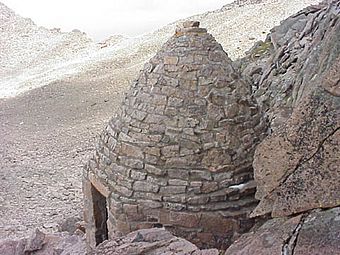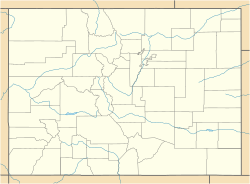Agnes Vaille Shelter facts for kids
Quick facts for kids |
|
|
Agnes Vaille Shelter
|
|
 |
|
| Nearest city | Estes Park, Colorado |
|---|---|
| Area | Less than one acre |
| Built | 1927 and 1935 |
| Built by | National Park Service |
| Architectural style | NPS Rustic |
| MPS | Rocky Mountain National Park MRA |
| NRHP reference No. | 92001669 |
| Added to NRHP | December 24, 1992 |
The Agnes Vaille Shelter is a unique stone building shaped like a beehive. You can find it along the E. Longs Peak Trail in Rocky Mountain National Park, Colorado, USA. This shelter is close to the top of Longs Peak, a very tall mountain.
The first shelter was built in 1927 by the National Park Service. This was done after several climbers sadly passed away while trying to climb Longs Peak. The shelter was named after Agnes Vaille. She died on January 12, 1925, while coming down from the first winter climb of the east side of Longs Peak. Another person, Herbert Sortland, also died trying to rescue her. Agnes Vaille's family rebuilt the shelter in 1935.
Contents
Who Was Agnes Vaille?
Agnes Wolcott Vaille was born in 1890. She went to Smith College and came from a well-known family in Denver. Her father was the head of the first telephone company in Denver.
During World War I, Agnes helped out overseas. She volunteered for the Red Cross. After the war, she became the secretary of the Denver Chamber of Commerce.
Agnes loved climbing mountains. She was a member of the Colorado Mountain Club. She even led outdoor trips for the club. Agnes was also one of the first members of the '14,000 Footers Club'. This club is for people who climb mountains taller than 14,000 feet. In 1923, she was the first person known to climb James Peak alone in winter. A famous climber named Carl Blaurock said Agnes was "a strong, husky woman, just crazy about climbing."
The Tragic Climb on Longs Peak
Agnes Vaille met Walter Kiener in the Colorado Mountain Club. They decided to be the first climbers to reach the top of the east face of Longs Peak in winter. They tried three times but didn't succeed. Their fourth attempt began on the morning of January 11, 1925.
On January 12, 1925, they reached the peak at 4:00 a.m. It was extremely cold, about -14 degrees Fahrenheit (or -26 degrees Celsius). As they climbed down, the temperature dropped even more. The wind also got stronger.
At about 13,000 feet (3,962 meters), Agnes slipped. She fell about 100 to 150 feet (30 to 46 meters). She survived the fall but was very tired. Her hands and feet were frozen. Walter Kiener went to get help. But when rescuers arrived, Agnes had passed away from being too cold (hypothermia).
One of the rescuers, Herbert Sortland, also died. He broke his hip in a fall and then died from hypothermia. His body was found later in February.
Agnes Vaille was buried in Fairmount Cemetery in Denver, Colorado.
About the Agnes Vaille Shelter
The first stone shelter was built in 1927. Roger Toll, who was the Superintendent of Rocky Mountain National Park, oversaw its construction. He was also Agnes Vaille's cousin.
The shelter you see today was built by Agnes's family in 1935. It replaced the first one. The shelter was designed to fit in with the natural landscape. This style is called National Park Service rustic. It is located high up, above 13,400 feet (4,084 meters). This area is known as the Boulder Field. The stones used to build the shelter came from this very area.
The shelter has one round room. Its roof is shaped like a cone. There is a single doorway, but the door is no longer there. This means snow can sometimes fill part of the inside, even in summer. There are two windows with glass and one opening that has been filled in. The floor is made of stone.
Near the shelter, there is a special plaque. It says:
Agnes Wolcott Vaille
This shelter commemorates
a Colorado mountaineer
conquered by winter after
scaling the precipice
January 12, 1925
and one who lost his life
in an effort to aid her
Herbert Sortland
The Agnes Vaille Shelter was added to the National Register of Historic Places on December 24, 1992. This means it's an important historical site.
Walter Kiener's Story
Walter Kiener was born in Bern, Switzerland. His father made sausages. Walter left school at 15 to help his family. In his free time, he became a very skilled mountaineer in the Alps. After serving in the military, he moved to the United States.
Walter arrived in Denver in 1923. He got a job as a butcher. He joined the Colorado Mountain Club, where he met Agnes Vaille.
Walter suffered severe frostbite from the Longs Peak climb. He lost several fingers, most of his toes, and part of a foot. Agnes Vaille's father was very thankful for Walter's attempt to rescue Agnes. He paid for Walter's medical bills.
Because of his injuries, Walter could no longer work as a foreman at a sausage factory. Superintendent Toll gave him a job as a seasonal ranger. He worked at the fire lookout station on top of Twin Sisters for five summers.
With financial help from the Vaille family, Walter went to the University of Nebraska. He studied biology and graduated in 1930. He earned his master's degree in 1931 and his Ph.D. in 1940. His doctoral paper was about the plants found in the mountains around Longs Peak.
Walter Kiener taught at the University of Nebraska. He also became the chief biologist for the State of Nebraska Game, Forestation, and Parks Commission. He started the Nebraska Game Commission's Fisheries Research Department. He passed away on August 24, 1959. Walter's large collection of plant samples and notes is kept at the University of Nebraska State Museum.



